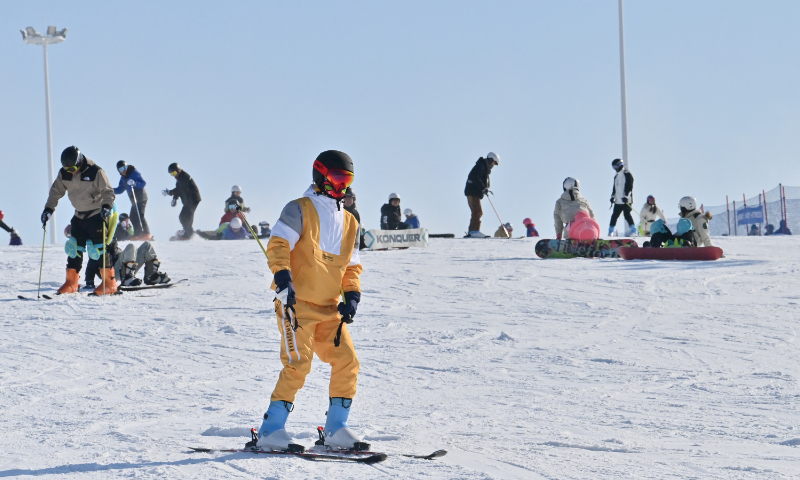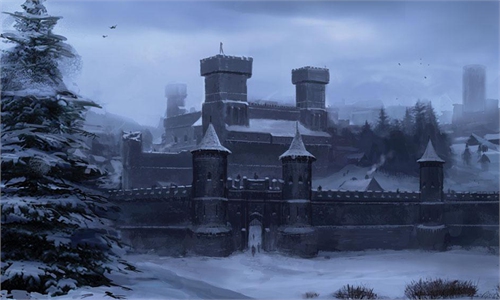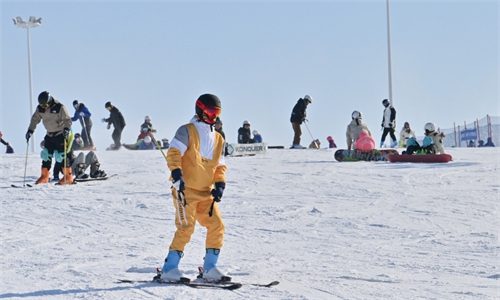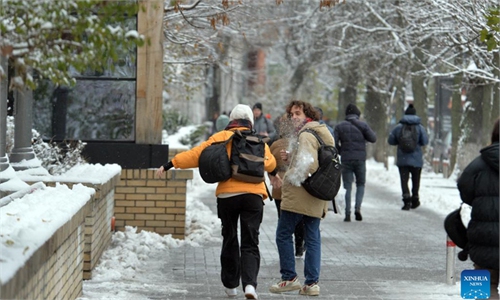Hot tourism season hits Chinese cities in chilly winter; 'ice and snow economy' gains momentum

Skiers start their first skiing tour of the winter at the Tiandingshan Ski Resort in Changchun, Northeast China's Jilin Province, on November 11, 2023. Photo: VCG
While the temperature continues to drop, a growing hot tourism season is sweeping Chinese cities. Local governments are issuing tourism consumption coupons, and scenic spots are introducing innovative business models, fueling the momentum of the "ice and snow economy" and highlighting China's robust consumer potential.
A Shanghai resident surnamed Guo told the Global Times on Monday that she had just returned from Northwest China's Xinjiang Uygur Autonomous Region, where she took her first skiing this year. "I saved up my annual leave for this trip," she said.
As a veteran skier, Guo has visited many ski resorts in China and abroad. However, she now finds that domestic ski resorts are developing rapidly, with excellent commercialization and services. She said that the ski resorts in Hemu, Xinjiang are "YYDS" - an internet slang term popular among young Chinese people, which roughly means "greatest of all time."
"Though many ski resorts have just opened for business this winter, they already have many visitors, including many four- to five-year-olds who ski pretty well," a Beijing resident surnamed Liu told the Global Times on Monday. She enjoyed her first skiing this year in Beijing on November 27.
Citing her skiing coach, Liu said that skiing is becoming increasingly popular in China, and such skills need to be cultivated from a young age.
The city of Harbin, capital of Northeast China's Heilongjiang Province, and Changbai Mountain in Antu county, Northeast China's Jilin Province, are among the popular destinations for tourists this winter, Jia Jianqiang, CEO of Beijing-based online agency 6renyou, told the Global Times on Monday.
"We had received a lot of inquiries recently and the winter tourism season this year is obviously much hotter than last year," Jia said.
It is the first complete winter tourism season after the COVID-19 pandemic, and many of the attractions that have just begun their winter operations are already bustling. This winter tourism season will be very hot, Jiang Yiyi, a deputy head of the School of Leisure Sports and Tourism at Beijing Sport University, told the Global Times on Monday.
Winter used to be a slack season for tourism in China, but that's been changing in recent years with more and more winter tourism resources being developed, Jiang said.
The warming trend in "ice and snow" tourism is not only supported by local policies but also driven by scenic spots introducing innovative products and services, coupled with the boost from the Beijing 2022 Winter Olympics, Jiang noted.
The surge in the winter tourism market not only mirrors the overall increase in income levels among Chinese residents but also serves as a catalyst for local economic development, she said.
Jilin is distributing 30 million yuan ($4.2 million) worth of "ice and snow" consumption coupons to both local and out-of-town tourists, according to media reports.
The number of people who participate in winter sports in China has surpassed 346 million, with a resident participation rate of 24.56 percent. Winter sports have gradually overcome spatial and temporal constraints, evolving into a sector of mass participation, according to the 2023 China Ice-snow Tourism Development Report released by the China Tourism Academy in February.
It estimates that the number of winter tourists in China will exceed 300 million during the snow season from 2023 to 2024 and reach 520 million from 2024 to 2025, with a total income of 720 billion yuan.



